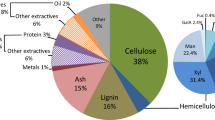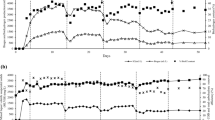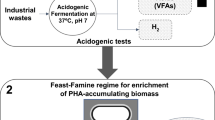Abstract
Efficient utilization of carbon inputs is critical to the economic viability of the current forest products sector. Input carbon losses occur in various locations within a pulp mill, including losses as volatile organics and wastewater. Opportunities exist to capture this carbon in the form of value-added products such as biodegradable polymers. Waste-activated sludge from a pulp mill wastewater facility was enriched for 80 days for a methanol-utilizing consortium with the goal of using this consortium to produce biopolymers from methanol-rich pulp mill waste streams. Five enrichment conditions were utilized: three high-methanol streams from the kraft mill foul condensate system, one methanol-amended stream from the mill wastewater plant, and one methanol-only enrichment. Enrichment reactors were operated aerobically in sequencing batch mode at neutral pH and 25°C with a hydraulic residence time and a solids retention time of 4 days. Non-enriched waste activated sludge did not consume methanol or reduce chemical oxygen demand. With enrichment, however, the chemical oxygen demand reduction over 24-h feed/decant cycles ranged from 79 to 89%, and methanol concentrations dropped below method detection limits. Neither the non-enriched waste-activated sludge nor any of the enrichment cultures accumulated polyhydroxyalkanoates (PHAs) under conditions of nitrogen sufficiency. Similarly, the non-enriched waste activated sludge did not accumulate PHAs under nitrogen-limited conditions. By contrast, enriched cultures accumulated PHAs to nearly 14% on a dry weight basis under nitrogen-limited conditions. This indicates that selectively enriched pulp mill waste activated sludge can serve as an inoculum for PHA production from methanol-rich pulp mill effluents.






Similar content being viewed by others
References
Miller, M., Justiniano, M., & McQueen, S. (2005). Energy and environmental profile of the U.S. pulp and paper industry. Washington, DC: U.S. Department of Energy, Office of Energy Efficiency and Renewable Energy, Industrial Technologies Program.
Dufresne, R., Liard, A., & Blum, M. S. (2001). Anaerobic treatment of condensates: Trial at a kraft pulp and paper mill. Water Environment Research, 73(1), 103–109.
Springer, A. M. (2000). Industrial environmental control pulp and paper industry, (3rd ed., pp. 238–239). Atlanta, GA: Tappi Press.
Smook, G. A. (1992). Handbook for pulp & paper technologists, (2nd ed., p. 382). Bellingham, WA: Angus Wilde Publications.
Madison, L. L., & Huisman, G. W. (1999). Metabolic engineering of poly(3-hydroxyalkanoates): From DNA to plastic. Microbiology and Molecular Biology Reviews, 63(1), 21–53.
Anderson, A. J., & Dawes, E. A. (1990). Occurrence, metabolism, metabolic role, and industrial uses of bacterial polyhydroxyalkanoates. Microbiological Reviews, 54(4), 450–472.
Dionisi, D., Majone, M., Papa, V., & Beccari, M. (2004). Biodegradable polymers from organic acids by using activated sludge enriched by aerobic periodic feeding. Biotechnology and Bioengineering, 85(6), 569–579.
Braunegg, G., Lefebvre, G., & Genser, K. F. (1998). Polyhydroxyalkanoates, biopolyesters from renewable resources: Physiological and engineering aspects. Journal of Biotechnology, 65(2–3), 127–161.
Smith, P. M., & Wolcott, M. P. (2006). Opportunities for wood/natural fiber–plastic composites in residential and industrial applications. Forest Products Journal, 56(3), 4–11.
Coats, E. R., Loge, F. J., Englund, K., & Wolcott, M. P. (2007). Production of natural fiber reinforced thermoplastic composites through the use of PHB-rich biomass. Bioresource Technology, DOI 10.1016/j.biortech.2007.03.065, in press.
Philip, S., Keshavarz, T., & Roy, I. (2007). Polyhydroxyalkanoates: Biodegradable polymers with a range of applications. Journal of Chemical Technology and Biotechnology, 82(3), 233–247.
Reis, M. A. M., Serafim, L. S., Lemos, P. C., Ramos, A. M., Aguiar, F. R., & Van Loosdrecht, M. C. M. (2003). Production of polyhydroxyalkanoates by mixed microbial cultures. Bioprocess and Biosystems Engineering, 25(6), 377–385.
Satoh, H., Iwamoto, Y., Mino, T., & Matsuo, T. (1998). Activated sludge as a possible source of biodegradable plastic. Water Science & Technology, 38(2), 103–109.
Satoh, H., Mino, T., & Matsuo, T. (1999). PHA production by activated sludge. International Journal of Biological Macromolecules, 25, 105–199.
Atlas, R. M. (1997). Handbook of microbiological media, (2nd ed., p. 891). Boca Raton, FL: CRC Press.
Bourque, D., Ouellette, B., Andre, G., & Groleau, D. (1992). Production of poly-β-hydroxybutyrate from methanol: Characterization of a new isolate of Methylobacterium extorquens. Applied Microbiology and Biotechnology, 37(1), 7–12.
Kim, S. W., Kim, P., Lee, H. S., & Kim, J. H. (1996). High production of poly-β-hydroxybutyrate (PHB) from Methylobacterium organophilum under potassium limitation. Biotechnology Letters, 18(1), 25–30.
Suzuki, T., Yamane, T., & Shimizu, S. (1986). Mass production of poly-β-hydroxybutyric acid by fully automatic fed-batch culture of methylotroph. Applied Microbiology and Biotechnology, 23(5), 322–329.
Bormann, E. J., Leissner, M., & Beer, B. (1997). Growth and formation of poIy(hydroxybutyric acid) by Methylobacterium rhodesianum at methanol concentrations of above 25 g/l. Acta Biotechnologica, 17(4), 279–289.
Weast, R. C. (1984). Handbook of chemistry and physics (64th ed.). Boca Raton, FL: CRC Press.
APHA (1992). Standard methods for the examination of water and wastewater (20th ed.). Washington D.C.: American Public Health Association.
Braunegg, G., Sonnleitner, B., & Lafferty, R. M. (1978). A rapid gas chromatographic method for the determination of poly-β-hydroxybutyric acid in microbial biomass. European Journal of Applied Microbiology and Biotechnology, 6(1), 29–37.
Gentile, M. E., Jessup, C. M., Nyman, J. L., & Criddle, C. S. (2007). Correlation of functional instability and community dynamics in denitrifying dispersed-growth reactors. Applied and Environmental Microbiology, 73(3), 680–690.
Briones, A., & Raskin, L. (2003). Diversity and dynamics of microbial communities in engineered environments and their implications for process stability. Current Opinions in Biotechnology, 14, 270–276.
Kaewpipat, K., & Grady, J. C. P. L. (2002). Microbial population dynamics in laboratory-scale activated sludge reactors. Water Science & Technology, 46(1–2), 19–27.
Kymäläinen, M., Holmström, M., Forssén, M., & Hupa, M. (2001). The fate of nitrogen in the chemical recovery process in a kraft pulp mill. Part III: The effect of some process variables. Journal of Pulp and Paper Science, 27(9), 317–324.
Kymäläinen, M., Forssén, M., & Hupa, M. (1999). The fate of nitrogen in the chemical recovery process in a kraft pulp mill. Part I. A general view. Journal of Pulp and Paper Science, 25(12), 410–417.
Dionisi, D., Beccari, M., Di Gregorio, S., Majone, M., Papini, M. P., & Vallini, G. (2005). Storage of biodegradable polymers by an enriched microbial community in a sequencing batch reactor operated at high organic load rate. Journal of Chemical Technology and Biotechnology, 80, 1306–1318.
Salehizadeh, H., & Loosdrecht M. C. M. V. (2004). Production of polyhydroxyalkanoates by mixed culture: Recent trends and biotechnological importance. Biotechnology Advances, 22(3), 261–279.
Serafim, L. S., Lemos, P. C., Oliveira, R., & Reis, M. A. M. (2004). Optimization of polyhydroxybutyrate production by mixed cultures submitted to aerobic dynamic feeding conditions. Biotechnology and Bioengineering, 87(2), 145–160.
Chua, H., Yu, P. H. F., & Ma, C. K. (1999). Accumulation of biopolymers in activated sludge biomass. Applied Biochemistry and Biotechnology, 77–79(1–3), 389–399.
Ma, C. K., Chua, H., Yu, P. H. F., & Hong, K. (2000). Optimal production of polyhydroxyalkanoates in activated sludge biomass. Applied Biochemistry and Biotechnology, 84(1–9), 981–990.
Acknowledgements
This work is supported by the U.S. Department of Energy, Industrial Technologies Program, Forest Products Industries of the Future, under DOE-NE Idaho Operations Office Contract DE-AC07-05ID14517. The authors are grateful to Katherine Wiedeman and James Flanders of P. H. Glatfelter for providing access to their facility, the activated sludge, and the foul condensates. The authors also thank Cathy Rae of the INL for performing the PHA analyses.
Author information
Authors and Affiliations
Corresponding author
Rights and permissions
About this article
Cite this article
Mockos, G.R., Smith, W.A., Loge, F.J. et al. Selective Enrichment of a Methanol-Utilizing Consortium Using Pulp and Paper Mill Waste Streams. Appl Biochem Biotechnol 148, 211–226 (2008). https://doi.org/10.1007/s12010-007-8028-8
Received:
Accepted:
Published:
Issue Date:
DOI: https://doi.org/10.1007/s12010-007-8028-8




